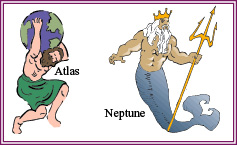

 One of the more common challenges of atheists is that
people who argue for the existence of God are simply using the
"God-of-the-gaps" argument to support their belief system. There is no
question that this has happened in the past and that it is an easy trap
to fall into. In ancient times there were cultures that explained the
weather by inventing gods and goddesses that produced weather
phenomena. Many of us remember names like Thor and Minerva who were
said to cause lightning and rain. People did not understand how
lightning was produced or what it took to make rain so they invented
deities to do this explaining. Many ancient people worshipped the sun
or moon or the volcano goddess Pele because they did not understand
these objects and invented gods or goddesses to explain their origin
and how they function. This is what god-of-the-gaps
means: to explain something you do not understand by inventing a
god or goddess to do the explaining.
One of the more common challenges of atheists is that
people who argue for the existence of God are simply using the
"God-of-the-gaps" argument to support their belief system. There is no
question that this has happened in the past and that it is an easy trap
to fall into. In ancient times there were cultures that explained the
weather by inventing gods and goddesses that produced weather
phenomena. Many of us remember names like Thor and Minerva who were
said to cause lightning and rain. People did not understand how
lightning was produced or what it took to make rain so they invented
deities to do this explaining. Many ancient people worshipped the sun
or moon or the volcano goddess Pele because they did not understand
these objects and invented gods or goddesses to explain their origin
and how they function. This is what god-of-the-gaps
means: to explain something you do not understand by inventing a
god or goddess to do the explaining.
The god-of-the-gaps mentality is not confined to beliefs about
deity. When I was in Scotland many years ago, there was a local ghost
at a castle that many people believed in. Strange sounds that took
place at various times of the day were explained in terms of a ghost
that was warning people to stay out of the castle. As we visited, I was
able to see physical reasons for those strange sounds. The howling in
the evening was  wind blowing through open spots in
the windows in the bell tower. The chains dragging across the floor was
contraction and expansion of the large rocks that made up the floor of
upper rooms. They made sounds as the temperatures changed with the
cooling and heating from the open doors and windows. Everything
ascribed to a ghost could be explained in terms of known physics. The
ghost was a god-of-thegaps ghost, produced by the ignorance of some of
the local people.
wind blowing through open spots in
the windows in the bell tower. The chains dragging across the floor was
contraction and expansion of the large rocks that made up the floor of
upper rooms. They made sounds as the temperatures changed with the
cooling and heating from the open doors and windows. Everything
ascribed to a ghost could be explained in terms of known physics. The
ghost was a god-of-thegaps ghost, produced by the ignorance of some of
the local people.
Religious people have certainly been guilty of using god-of-the-gaps thinking in the past. Claims of miracles have sometimes turned out to be natural phenomena and not supernatural acts of God. I have a picture given to me by a friend that shows an appearance of the Virgin Mary. The vision is a very bright object in the sky which does in fact look like artistic portrayals of what Mary might have looked like. There is a blast of light rays behind the vision coming from above, and looking at the picture you can see why someone might believe that it is some kind of supernatural apparition. The photograph was taken in an area that is downwind from the famous volcano in the Philippines named Mount Pinatubo. What is happening is that there are several layers of clouds and heavy dust in the atmosphere. The sun is shining through a break on the upper clouds and is shining on a translucent layer of clouds in the lower atmosphere. The outline is shaped like the Virgin Mary, but that shape is coincidental and in fact did not last very long. There have been many other claims of miraculous visions and miracles that have easy scientific explanations, and there is no denial that believers have been guilty of god-of-the-gaps arguments in the past.


Cosmological arguments for the existence of God should not be made
from ignorance. We do not invent a god because of what we do not
understand. What we do is look at solid scientific choices about the
cosmos. Scientifically we can prove that there was a beginning to the
cosmos. If there was a beginning, then the beginning was caused. To say
it was not caused and that it was self-existing as the Humanist Manifesto claims puts one
at odds with all conservation laws of science, because one has to
maintain that something can come from nothing. What has to be the
nature of that cause? Since the beginning of the cosmos entails the
creation of time, space, and matter/energy, the cause must be an entity
that is outside of time, space, and matter/energy. We do not stop here
and say, "Well, that must have been God." There are other possibilities
for what might be external to these things which does not necessarily
involve God. String theory, parallel universes, virtual reality, and a
number of other alternatives have been offered. What one has to do is
look for evidence as to what properties the cause has. More and more scientists are saying that
string theory is not a workable hypothesis because it does not have any
way of being examined or experimentally tested. It is also important to
note that there are other properties of the cosmos which offer evidence
along these lines.
cause has. More and more scientists are saying that
string theory is not a workable hypothesis because it does not have any
way of being examined or experimentally tested. It is also important to
note that there are other properties of the cosmos which offer evidence
along these lines.
As one looks at the creation, one property continues to be obvious and that is the property of design and intelligence. The more we understand the cosmos, the more sophisticated we understand it to be. When I was in college many years ago the list of parameters necessary for a lifebearing planet to exist was fairly small. The Drake Equation which calculated the number of lifesupporting planets that could exist included just five variables. Thanks to the Hubble telescope and continued investigation in a wide range of sciences, we know there are at least 47 variables (Evidence for Design in the Universe) that would have to be carefully chosen to produce a lifesupporting planet. We also know that proposals that there could be life radically different than us and based on a different chemistry are simply bad science. The laws of chemistry do not allow such proposals to be seriously entertained.

Atheists will maintain that the design seen in all of life and in the physical arrangements that allows life to exist are all there because that is the only way life can in fact exist. When we see some wonderful survival technique in a bug or an animal an atheist will say that this technique came about by chance because if anything else had been there it would not have worked. Reasons can be given why animals do certain things, and evolutionary techniques explain how many animal characteristics come about.
 The first problem with such
assertions is the assumption that if I can give a theoretical
explanation as to why and how a certain behavior came about, that this
must be in fact what happened. Many times a proposed explanation turns
out to be totally bogus. One of my favorite examples of this is the
praying mantis. When praying mantis mate, the female will turn around
after the mating and bite the head off of the male and eat him. I have
seen biologists give a long elaborate discussion about what a wonderful
example this is of evolutionary process controlling populations,
solving food problems, and promoting survival of the fittest. I have
also heard atheists talk about how such a behavior is not compatible
with the God of the Bible because of its violence and cannibalistic
nature.
The first problem with such
assertions is the assumption that if I can give a theoretical
explanation as to why and how a certain behavior came about, that this
must be in fact what happened. Many times a proposed explanation turns
out to be totally bogus. One of my favorite examples of this is the
praying mantis. When praying mantis mate, the female will turn around
after the mating and bite the head off of the male and eat him. I have
seen biologists give a long elaborate discussion about what a wonderful
example this is of evolutionary process controlling populations,
solving food problems, and promoting survival of the fittest. I have
also heard atheists talk about how such a behavior is not compatible
with the God of the Bible because of its violence and cannibalistic
nature.
The problem with all of this is that this behavior does not occur in the real world. It happens in captivity where the animals are forced into close contact and no way of getting away from each other. The eating of the male is almost surely a protection of the babies, and in the wild the males simply leave and go elsewhere and there is no such cannibalistic process. Many times observations of animal behavior is skewed because of the effect of the observer. Human explanations are tentative at best. The fact that we can explain something also does not mean it is a chance process.
Evolutionary models of things also do not disprove God's role in whatever it is we observe. Sexual reproduction is a highly designed system that allows change in biological systems to occur. We could not have over 100 varieties of chickens if it were not for the fact that the reproductive systems of birds allow change. This is a design feature that is built into the system, and if asexual reproduction was the only method of reproduction we had, change and variety would never take place in biological populations. The incredible wisdom of the DNA molecule, and the way that molecule functions to allow organisms to adapt over time to a changing world is a wonderful work of intelligence.
Francis Collins the director of the Human Genome Project in his book The Language of God has pointed out that the whole process of genetic reproduction radiates intelligence and purpose and in its structure shows a plan and wisdom of incredible degree. It is tragic that some like Richard Dawkins have been allowed to stretch these characteristics to attempt to exclude intelligence and relegate everything to blind mechanistic materialism.
Statistics allow us to evaluate the probability of chance being the driving force behind all we see. Researchers from all kinds of philosophic and religious backgrounds have applied statistics to these discussions. The probability factors that all researchers arrive at are astronomically small. Most numbers are in the range of ten to an exponent that is in the hundreds. As more and more understanding has come about concerning how many factors are necessary to produce life and the systems that control life, that number goes higher and higher. Writers who get numbers like one chance in 10400 or one in 10800 include believers and atheists alike. Francis Crick, Sydney Fox, Fredrick Hoyle, Freeman Dyson, Murray Eden, and countless other scientists all come to the same numbers. We have reviewed many of these calculations in this journal through the years, but all calculations show astronomically small probabilities.
The atheist response to this will be that no matter what the odds are, if you have enough places and enough time it will happen. The problem with this assertion is that we do not have either infinite time or infinite space. If the cosmos began at a singularity, then there is a limit to both time and space. The most liberal estimates of the size of space and the length of time are on the order of ten to the twentieth. The probabilities we have mentioned are on the order of ten to the 400th, 800th, etc., power. They are not in the same range. The Dirac limit, the probability number that is considered to separate that which is possible from that which is not mathematically possible is considered to be ten to the 60th power. Statistics say you cannot just assume; you have to ask whether the proposal being asked is mathematically reasonable and chance explanations simply are not. That does not mean we automatically accept God as the answer, but it does mean that an alternative to chance must be found. Intelligence, purpose, and design certainly must be entertained as a possibility by any fair-minded, thinking person. This is not a god-of-thegaps proposal.

In recent years we have had attempts by people studying the brain and studying psychology to explain why man conceptualizes God and participates in worship. In the past there have been attempts to relegate belief to ignorance and stupidity. Lenin said that religion was the opiate of the people, implying that ignorant peasants believe in God, but the educated elite do not. Such arrogance is not supported by the evidence, because throughout history some of the most productive scientists have been people who were deeply religious. Materialism seems to be a better friend of atheism than does intelligence.
 In recent years
there have been
those who have maintained that there is a section of the human brain
which causes people to be religious and to engage in religious
practices. Let us just assume for a moment that this is true, although
evidence for it is sparse. Would this disprove the existence of God?
The answer is clearly not. What it would show is that in the design of
the human brain there is a provision for the spiritual, but the very
fact that we have atheists and agnostics show that this does not
robotically program us to be religious. It is interesting that some of
those who "blame" our brain for our religious beliefs and claim to be
superior to it also maintain that homosexuality is a brain trait which
gives the homosexual no choice but to be gay.
In recent years
there have been
those who have maintained that there is a section of the human brain
which causes people to be religious and to engage in religious
practices. Let us just assume for a moment that this is true, although
evidence for it is sparse. Would this disprove the existence of God?
The answer is clearly not. What it would show is that in the design of
the human brain there is a provision for the spiritual, but the very
fact that we have atheists and agnostics show that this does not
robotically program us to be religious. It is interesting that some of
those who "blame" our brain for our religious beliefs and claim to be
superior to it also maintain that homosexuality is a brain trait which
gives the homosexual no choice but to be gay.
Man is not just unique in his religious activity. Man is also unique in his concept of self, in his structure and use of language, in his creativity, and in his ability to do abstract thinking. There may be contributing factors of a physical nature to these things, but the soul and its existence is an observation shared by even people who deny the existence of God. Man is unique, and we can have different beliefs about how that uniqueness came to be, but it is evidence that causes us to speak about our souls, not ignorance.
Many items about mankind will always exist in a faith framework. Things like ones concept of self are not easily tested by science, and we may have different beliefs about how these things came about. In this journal we talk about evidence and give possibilities that are compatible with faith. Belief that we are created in the image of God with a soul are faith statements, but they are not blind faith. They are based on evidence and are supported by things we can observe. That belief leads to lifestyles and choices that are vital to successful living. We urge the person who rejects the concept that man has a soul and is created in the image of God to look at the alternatives, at not only the evidence but at where the belief system takes one. Does it lead to self esteem, productivity in life, security in death, and a belief in the equality of man? One of Jesus' key teachings is "By their fruits you will know them," and the fruit of the validity of one's beliefs speaks loudly that man's unique spiritual make-up is not an invented thing contrived because we have no other explanation. There is evidence. Know why you believe what you believe.
Back to Contents Does God Exist?, JulAug08.